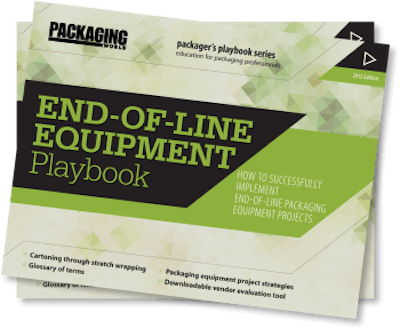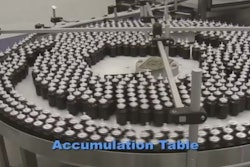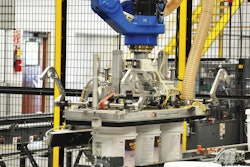In today’s multipacking and shrink bundling environment, the need for flexibility and precisely repeatable changeovers is taking precedence. This is driving equipment design, even on highly complex equipment. It is also influencing the “dumbing down of machines,” specific to changeover and flexibility, where responsibility is taken out of the hands of operators, or removed entirely. Users are demanding higher overall equipment effectiveness (OEE), longer mean time to failures, and greater predictability.
Machine builders are adding control with fully integrated robotics instead of integrating with another machine for added functionality. Rather than having three axes of linear movement (e.g., a pusher), the vendor may install a delta or Cartesian robot. Robots are simpler and cheaper than they used to be, and utilize smaller footprints.
The proliferation of SKUs and brands has driven down shelf space, which in turn has increased inventory turns and the desire for smaller packages. This need has dramatically increased bundling speed. The costs of bundling, labeling, and coding have almost doubled due to sending the same tonnage in smaller bundles!
Here are some tips to consider for those selecting equipment in this challenging environment:
1. Look to down-gauge. The use of polyethylene and similar thin films is a huge cost-cutting opportunity. Fifty percent of customers use heavier gauge film than they need. Why? A thicker gauge buys a lot of “forgiveness,” allowing companies to get away with sloppier setup, less efficient machines, and less competent operators. Premium films are being used to accommodate these shortcomings. While down-gauging involves a lot of work, it can pay off. Instead of using a film that costs $4 a pound, you can use one that costs $0.71 a pound with the right bundling machine. In fact, film suppliers are producing better-quality, inexpensive thin films.
2. Identify the right technology platform, especially if it’s a new process for the business. Whether it’s a wraparound tray, corrugated pad, or unsupported shrink bundle see what your product and distribution environment can handle. Rigid containers msuch as metal cans easily transition from a tray to a pad. But what if you’re dealing with a 3-ounce plastic bottle with an hourglass shape? Be very careful and do a lot of testing to see if it’s even possible to move from a tray to a pad to an overwrap. Shrink-only packs will obviously save corrugated costs, but such a move requires foresight and planning to ensure package integrity with package development experts.
3. Speed matters. The speed at which you’re packing or bundling is a key parameter. The number of products
on a pad or shrink bundled remains on the upside of the growth curve. Consider this as you examine potential equipment. While there are no hard and fast rules, the impact of product development on bundling speed cannot be ignored.
4. Size matters as well. Pay attention to the length of the shrink tunnel. Don’t undersize it. Film takes a certain amount of time to heat up and shrink. Selecting shorter heat tunnels with higher heats is not good logic. For higher speeds, tunnels can become long and are often a target for footprint reduction. Tunnels with small chambers have a tendency for hot spots that can result in poor packages.
5. Look for shrink tunnels with lower air velocity. Tunnels with high velocity airflow can disturb the film, causing more wrinkles.
6. Storage and handling issues are important. For shrink film, proper storage is essential. Are film roll tolerances within specifications (e.g., tension consistency, minimum edge curl)? Pay attention to what the equipment incorporates to manage film tension and consistency, features such as vacuum control for film edges.
7. Don’t shirk on capacity. Flexible robotics requires extra capacity; have one or two extras so if one machine fails, your whole line isn’t down. Designing in excess packing capacity can improve overall uptime.
8. Consider the ultimate environment and display. If a product is affected by temperature, case packing is preferable to shrink bundling. If product visibility is important, shrink packing is better, unless the product is affected by shrink bundling pressure.
9. Flexible implications. Flexible materials are having an impact on multi-packing. Certain flexible bags cannot be shrink bundled because they are prone to distortion; they must be tight-wrapped. Otherwise the shrink bundle could be fused onto the primary packaging.

























